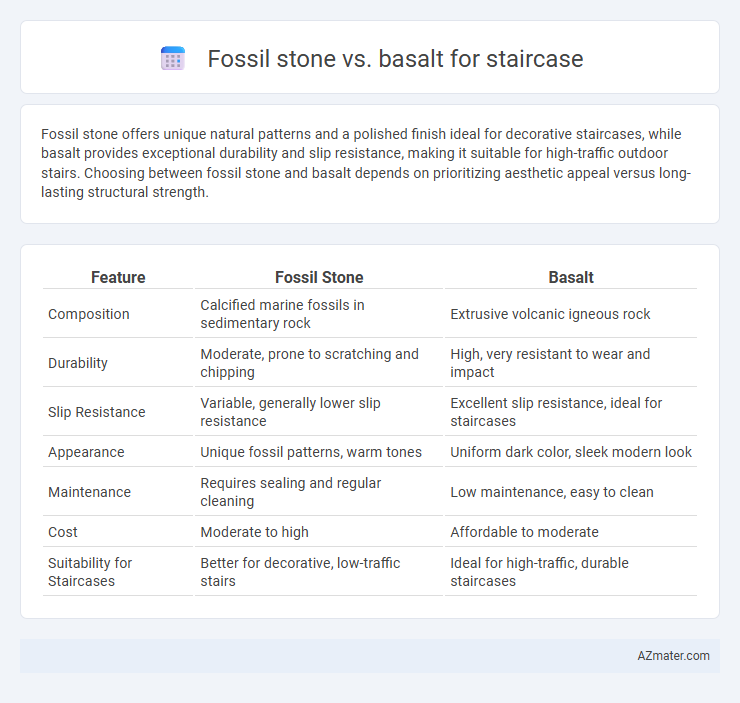Fossil stone offers unique natural patterns and a polished finish ideal for decorative staircases, while basalt provides exceptional durability and slip resistance, making it suitable for high-traffic outdoor stairs. Choosing between fossil stone and basalt depends on prioritizing aesthetic appeal versus long-lasting structural strength.
Table of Comparison
| Feature | Fossil Stone | Basalt |
|---|---|---|
| Composition | Calcified marine fossils in sedimentary rock | Extrusive volcanic igneous rock |
| Durability | Moderate, prone to scratching and chipping | High, very resistant to wear and impact |
| Slip Resistance | Variable, generally lower slip resistance | Excellent slip resistance, ideal for staircases |
| Appearance | Unique fossil patterns, warm tones | Uniform dark color, sleek modern look |
| Maintenance | Requires sealing and regular cleaning | Low maintenance, easy to clean |
| Cost | Moderate to high | Affordable to moderate |
| Suitability for Staircases | Better for decorative, low-traffic stairs | Ideal for high-traffic, durable staircases |
Introduction to Fossil Stone and Basalt
Fossil stone is a natural sedimentary rock composed primarily of preserved marine fossils embedded in limestone, prized for its unique textures and antique aesthetic in staircase designs. Basalt, an igneous volcanic rock characterized by its dense, fine-grained structure and dark color, offers exceptional durability and slip resistance, making it ideal for high-traffic staircases. Both materials provide distinct visual appeal and functional properties, with fossil stone emphasizing decorative elegance and basalt focusing on strength and longevity.
Geological Origins and Composition
Fossil stone, primarily composed of limestone rich in embedded ancient marine fossils, originates from sedimentary processes dating back millions of years. Basalt is an extrusive igneous rock formed from rapidly cooled lava, characterized by its fine-grained, dense composition of minerals like pyroxene and plagioclase. The contrast in geological origins--sedimentary versus volcanic--affects durability, texture, and aesthetic appeal for staircase applications.
Visual Appeal and Aesthetics
Fossil stone offers a unique visual appeal with its intricate patterns and embedded ancient fossils, creating a natural artwork that adds character and sophistication to staircases. Basalt provides a sleek, modern aesthetic with its uniform dark color and smooth texture, ideal for minimalist or industrial designs. Choosing between fossil stone and basalt depends on whether the desired aesthetic leans toward organic historical charm or contemporary elegance.
Durability and Strength Comparison
Fossil stone offers moderate durability with unique aesthetic appeal but generally has lower compressive strength compared to basalt, which is one of the hardest and most durable igneous rocks commonly used for staircases. Basalt's superior resistance to wear, chipping, and weathering makes it an ideal choice for high-traffic areas requiring long-lasting performance. When prioritizing strength and durability, basalt outperforms fossil stone, providing enhanced safety and longevity in staircase applications.
Slip Resistance and Safety
Fossil stone offers moderate slip resistance due to its natural texture, making it suitable for indoor staircases where moisture exposure is limited. Basalt provides superior slip resistance with its fine-grained, rough surface, enhancing safety on both indoor and outdoor stairs, especially in wet conditions. Choosing basalt for staircase construction significantly reduces the risk of slips and falls, ensuring a safer walking experience.
Maintenance and Cleaning Needs
Fossil stone staircases require gentle cleaning with non-acidic, pH-neutral cleaners to preserve the embedded fossils and avoid surface damage, making regular dusting and immediate stain removal essential for maintenance. Basalt staircases, being dense and highly durable, withstand more rigorous cleaning methods, including mild abrasives and acidic cleaners, offering easier upkeep with less frequent maintenance. Both materials benefit from periodic sealing to enhance resistance against stains and wear, but basalt's inherent hardness reduces long-term maintenance effort compared to fossil stone.
Cost Efficiency and Affordability
Fossil stone offers a unique aesthetic with moderate durability and typically comes at a higher price point compared to basalt, making it less cost-efficient for large-scale staircase projects. Basalt, known for its exceptional strength and weather resistance, provides greater affordability by requiring less maintenance and having a longer lifespan, which reduces long-term expenses. Choosing basalt enhances budget management without compromising on durability, whereas fossil stone is preferred for decorative appeal despite its higher initial investment.
Installation Process and Complexity
Fossil stone stairs require specialized handling during installation due to their natural fragility and uneven surface, demanding skilled craftsmanship and precise cutting to preserve fossil patterns. Basalt is denser and more uniform, which simplifies cutting and fitting but requires heavy-duty tools and experienced installers to manage its hardness and weight. Installation of basalt is generally more time-consuming because of its weight and need for secure anchoring, whereas fossil stone demands extra care to avoid damage during transport and placement.
Eco-Friendliness and Sustainability
Fossil stone and basalt differ significantly in eco-friendliness and sustainability for staircase construction. Fossil stone is a natural sedimentary rock rich in preserved organic material, offering a unique aesthetic with moderate environmental impact due to localized quarrying. Basalt, a dense volcanic igneous rock, boasts high durability and thermal mass, promoting longevity and reducing material replacement while its quarrying process can be more energy-intensive but supports greater recycling potential in construction.
Application Suitability for Staircases
Fossil stone offers unique aesthetic appeal and moderate durability, making it suitable for decorative staircase applications where visual impact is prioritized over heavy wear resistance. Basalt, known for its exceptional hardness and slip resistance, provides superior performance in high-traffic staircase environments, ensuring long-term durability and safety. Choosing between fossil stone and basalt depends on balancing design preferences with functional requirements like abrasion resistance and maintenance demands.

Infographic: Fossil stone vs Basalt for Staircase
 azmater.com
azmater.com